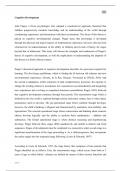1
Cognitive Development
John Piaget, a Swiss psychologist who adopted a constructivist approach, theorised that
children progressively construct knowledge and an understanding of the world through
coordinating experiences and interactions with their environment. The focus of this theory is
placed on cognitive developmental changes. Piaget states that knowledge is developed
through the physical and logical aspects of mathematical experience; however, this has been
criticised for its underestimation of the ability of children and its lack of theory for stages
beyond that of adolescent. This essay will discuss the strengths and weaknesses of Piaget’s
theory of cognitive development, as well the implications of understanding the adaption of
this theory in a South African context.
Piaget’s theoretical approach to cognitive development describes two processes required for
learning. The first being equilibrium, which is finding the fit between old schemas and new
environmental experiences. (Swartz, de la Rey, Duncan, Townsend, & O'Neill, 2016) And
the second is adaptation, which comprises of dual complementary processes: the capacity to
change the existing schema to incorporate new experiences (accommodation) and integrating
new experiences into evolving or completed structures (assimilation) Piaget (1952) believed
that cognitive development continues through four periods. The sensorimotor stage which is
defined by how the world is explored through sensory and motor contact, here is when object
permanence starts to develop. The pre-operational stage where symbolic thought develops;
however, the child’s thinking is illogical and characterised by centration, irreversibility, and
egocentrism. The concrete operational stage where conservation and thinking about concrete
objects develop logically and the ability to perform basic mathematics – addition and
subtraction. The formal operational stage is where abstract reasoning and hypothesising
develops. Piaget believed these stages differ qualitatively and unfold in distinct and fixed
sequences. Stages of development must be completed in a consecutive order as each stage is a
significant transformation of the stage proceeding it. As a child progresses, they incorporate
the earlier stages into the sequential stage following. (Louw & Edwards, 1997)
According to Louw & Edwards, 1997, the stage theory that comprises of four periods that
Piaget identified are as follows. First, the sensorimotor stage, which occurs from birth to 2
years of age in which babies’ schemas are defined by means of their sensory functions and
2302734
, 2
motor actions, is where an infant’s major developmental objective is to develop co-ordination
between the senses and the motor activities. Another important milestone in this stage is
object permanence as the child must make a mental representation of something that is not
physically present. The second stage, from 2 to 5 years, is the pre-operational stage where
object permanence is the basis for the development of symbolic thought. This symbolic
thought develops and contributes to a more complex degree of thinking. This thinking can
also be flawed during this stage as it is egocentric whereby the child cannot see events from
another person’s point of view. Another characteristic that forms is animism, and this allows
the child to believe that all inanimate objects are as conscious as humans. The third stage is
between 6 to 11 years of age, the concrete operational stage. This is where thought starts to
develop logically and in an organised manner. Egocentrism from the prior stage diminishes
and reversibility, where a child can think in more than one direction, and decentration, where
a child can focus on more than one aspect of an object, develops. This also allows for
conservation to develop, where having the ability to grasp that certain characteristic of an
object can remain unchanged regardless of factors that it may undergo. During this stage, the
ability to categorise objects according to class, colour, size, and quantity is established.
Aswell as the ability to decenter, or focus on more than one feature of a problem at a time.
(Piaget & Cook, The Origins of Intelligence in Children, 1952) Finally, the fourth stage from
11 and above develops. This is referred to as the formal operational stage. This is where the
ability to formulate hypotheses and to test them logically develops. Here thought is entirely
freed from physical and perceptual constraints. (McLeod, 2018) This shows the child’s ability
to utilize hypothetical or abstract objects and thought. They can now manipulate ideas that
vary in several ways at once.
Piaget’s cognitive development theory has encouraged more research in cognitive
development and has enables people get a better understanding of changes in the thinking
process. His theory has enhanced educational and instructional strategies for children as well.
Piaget has also emphasised the importance of children developing certain cognitive aspects in
specified stages. Breaking these stages up into four segments has shown the developmental
path a child takes as it ages from an infant. The cognitive development hypothesis of Piaget
explains how a child builds a mental representation of the world. Piaget rejected the notion
that intelligence was a fixed trait, instead seeing cognitive development because of bodily
maturation and interaction with the environment. When attempting to increase usefulness, the
2302734




